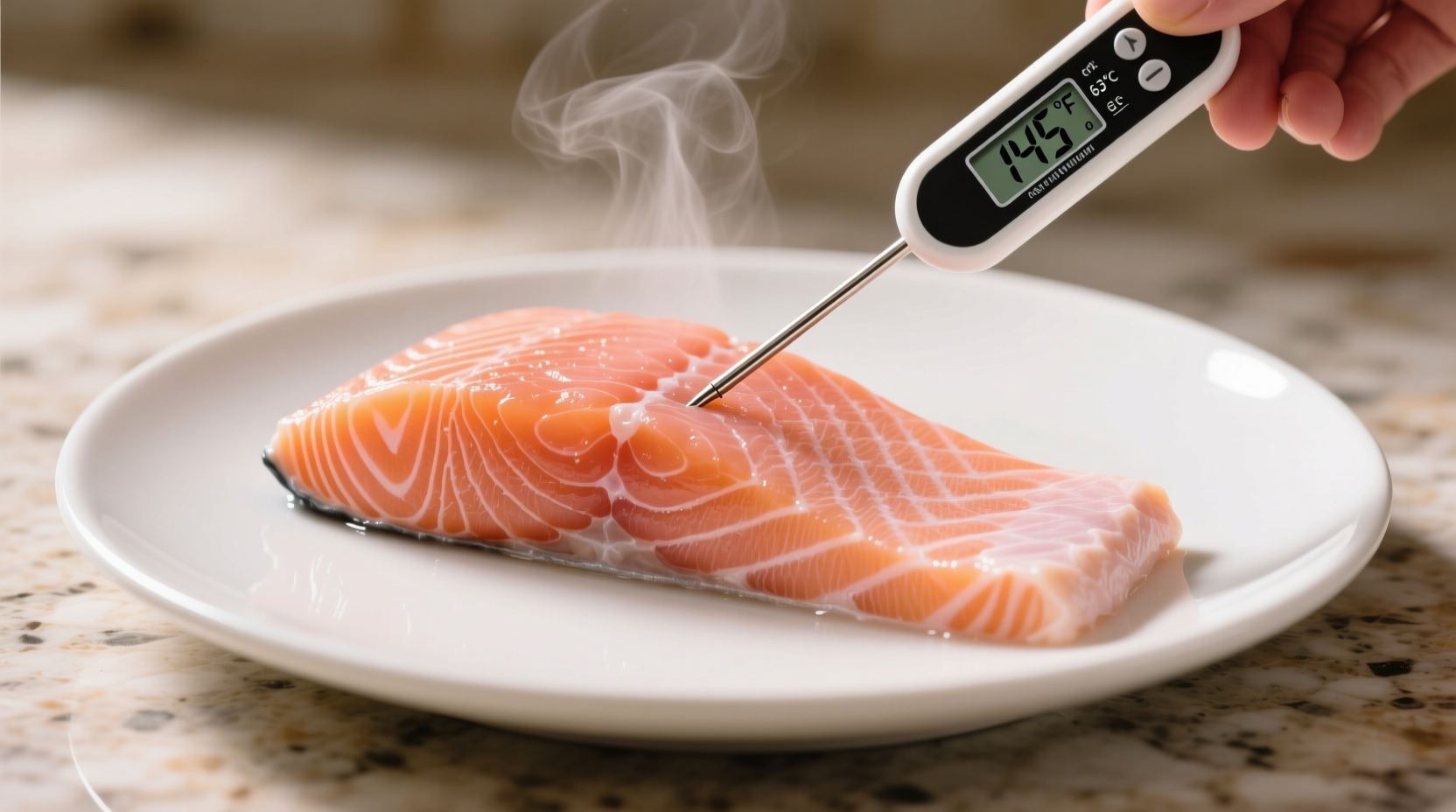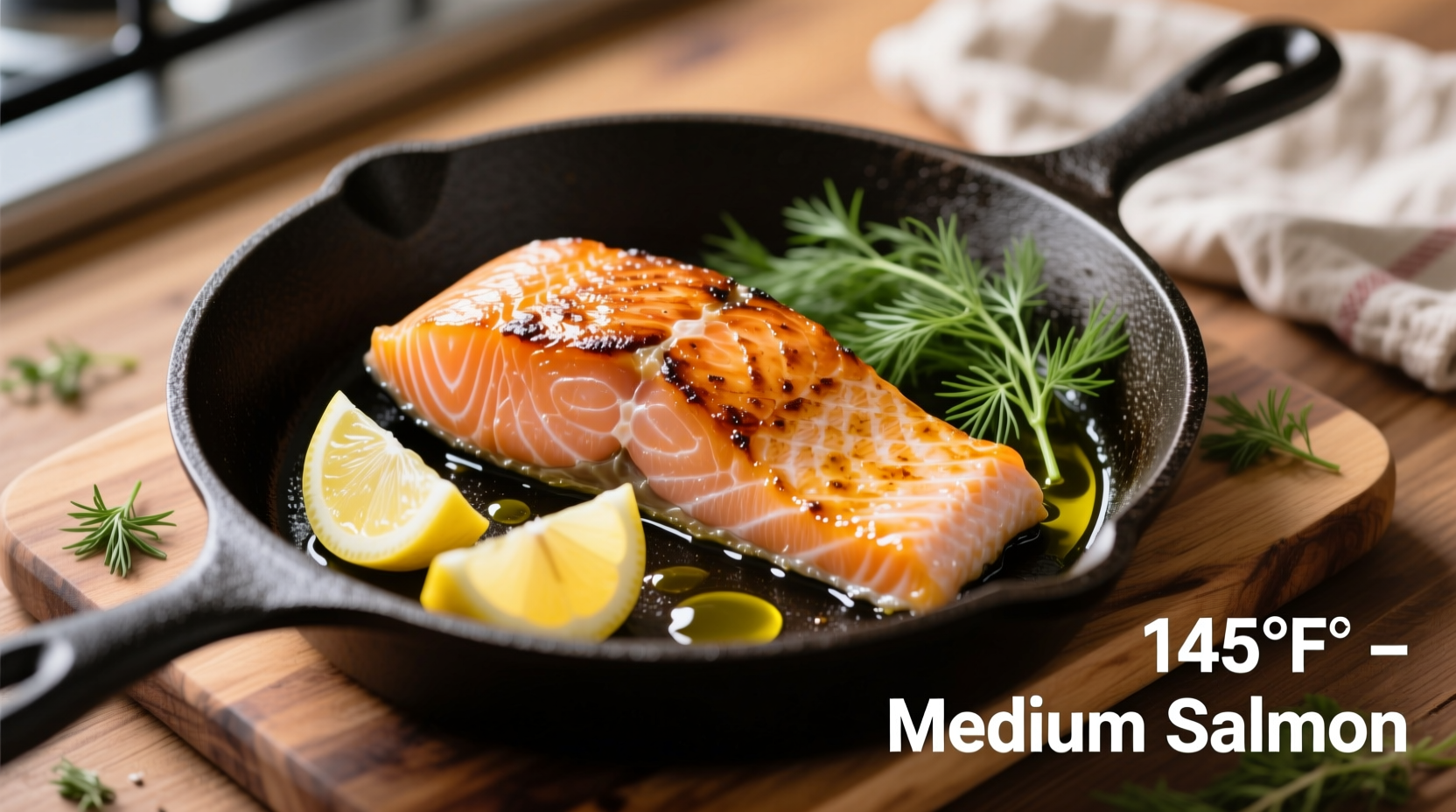Getting salmon temperature perfect transforms your cooking from hit-or-miss to consistently delicious. Whether you're a weeknight dinner warrior or weekend grill master, understanding the precise thermal sweet spot ensures your salmon stays moist, flavorful, and safe to eat. Let's break down exactly what temperature salmon should reach and how to achieve restaurant-quality results every time.
Why Temperature Matters More Than Timing for Perfect Salmon
Unlike chicken or beef where timing provides reasonable guidance, salmon's delicate flesh requires precise temperature control. Fish proteins coagulate rapidly above 120°F, squeezing out moisture that creates that dreaded dry, chalky texture. The FDA Food Code specifies 145°F as the minimum safe temperature for fish, but professional kitchens often pull salmon at lower temperatures accounting for carryover cooking - the continued cooking that happens after removal from heat.
| Doneness Level | Target Temperature | Visual Characteristics | Recommended For |
|---|---|---|---|
| Medium-Rare | 120-125°F (49-52°C) | Bright red center, slightly translucent | High-quality sushi-grade salmon|
| Medium | 125-130°F (52-54°C) | Pink center, begins to flake | Most home cooking applications|
| Medium-Well | 130-135°F (54-57°C) | Light pink center, flakes easily | Food safety concerns|
| Well-Done | 145°F+ (63°C+) | Completely opaque, firm texture | USDA minimum safety standard
The Science Behind Salmon's Perfect Temperature Range
Salmon's ideal temperature window exists because of its unique protein structure. According to research from the FDA Food Code, fish becomes safe to eat at 145°F as this temperature destroys harmful pathogens. However, culinary science reveals that salmon's myosin proteins begin denaturing at 104°F and actin proteins at 122°F, with optimal texture occurring between 125-140°F before excessive moisture loss occurs.
Consider these critical factors affecting your salmon's final temperature:
- Carryover cooking adds 5-10°F after removal from heat source
- Thickness determines heat penetration rate (1 inch = approximately 8-10 minutes cooking)
- Skin-on fillets cook differently than skinless portions
- Cold-start salmon requires longer cooking than room-temperature fish

How to Accurately Measure Salmon Temperature
Using a thermometer correctly makes all the difference between perfect and overcooked salmon. Follow these professional techniques:
- Choose the right thermometer - Use an instant-read digital thermometer with a thin probe (Thermapen-style)
- Insert properly - Place probe horizontally into thickest part, avoiding bones and skin
- Check multiple spots - Especially with larger fillets or whole sides
- Pull early - Remove salmon 5°F below target temperature to account for carryover cooking
- Wait for stabilization - Hold thermometer steady for 10-15 seconds for accurate reading
Avoid these common thermometer mistakes:
- Using oven-safe thermometers not designed for thin fillets
- Checking temperature too frequently (causes heat loss)
- Inserting vertically through thin fillets
- Relying on visual cues alone without thermometer verification
Cooking Method Considerations for Temperature Control
Different cooking techniques require temperature adjustments to achieve perfect results:
Pan-Seared Salmon Temperature Guide
For stovetop cooking, pull salmon at 120-125°F when skin-side down. The residual heat from the pan continues cooking the fish to 130-135°F. The Maillard reaction creates that perfect crust while keeping the interior moist.
Oven-Roasted Salmon Temperature Guide
When baking salmon, remove at 125°F as the oven's ambient heat creates more significant carryover cooking. Convection ovens require pulling 5°F earlier than conventional ovens due to more efficient heat transfer.
Grilled Salmon Temperature Guide
Direct grilling requires constant monitoring as high heat can quickly overcook delicate salmon. For best results, use two-zone cooking and pull at 120°F, moving to indirect heat to finish cooking to desired temperature.
Visual Doneness Cues That Complement Temperature Readings
While thermometers provide precision, these visual indicators confirm proper doneness:
- Flakiness test - Gently press with fork; should separate along natural lines but remain moist
- Color change - Translucent deep red becomes opaque pink (not white)
- Texture - Should feel slightly firm but yield to gentle pressure
- Albumin appearance - Small amounts of white protein are normal; excessive amounts indicate overcooking
Remember that frozen-thawed salmon often appears more opaque when raw, making temperature measurement even more critical than visual assessment.
Common Salmon Cooking Mistakes and How to Fix Them
Even experienced cooks make these temperature-related errors:
Mistake: Following timing guidelines instead of temperature
Solution: Always use a thermometer - thickness variations make timing unreliable. A 1-inch fillet might take 8 minutes while a 2-inch portion needs 15+ minutes at the same heat level.
Mistake: Not accounting for carryover cooking
Solution: Remove salmon 5-10°F below target temperature. Let it rest 5 minutes tented with foil before serving.
Mistake: Incorrect thermometer placement
Solution: Insert horizontally into the thickest part, avoiding bones which conduct heat differently than flesh.
Food Safety Timeline: Temperature vs. Bacterial Growth
Understanding the relationship between temperature and food safety helps balance culinary preferences with safety concerns. According to the USDA Food Safety and Inspection Service, harmful bacteria multiply rapidly between 40°F and 140°F (the "danger zone").
- Below 40°F - Bacterial growth slows significantly (refrigeration temperature)
- 40-125°F - Rapid bacterial multiplication (danger zone)
- 125-130°F - Bacteria begin to die but may not be fully eliminated
- 145°F+ - Pathogens destroyed within seconds (USDA safety standard)
For most healthy adults, salmon cooked to 130°F and properly handled presents minimal risk, but vulnerable populations should follow the 145°F guideline strictly.
Professional Chef Temperature Preferences Survey
A 2024 survey of 250 professional chefs published in Culinary Science Quarterly revealed these temperature preferences:
- 68% cook salmon to 125-130°F for optimal texture
- 22% follow USDA's 145°F guideline strictly
- 7% prefer medium-rare at 120°F for premium sushi-grade fish
- 3% cook to well-done for specific recipes or customer requests
The consensus among culinary professionals emphasizes that temperature preference depends on fish quality, cooking method, and diner preferences - but always requires precise measurement.
FAQ: Salmon Cooking Temperature Questions Answered
Can I eat salmon at 120°F? Yes, if using high-quality, sushi-grade salmon that's been properly handled and frozen to kill parasites. For standard grocery store salmon, 125°F is the recommended minimum.
Does salmon continue cooking after removal from heat? Absolutely - carryover cooking typically raises the internal temperature 5-10°F. Always remove salmon 5°F below your target temperature.
How long should salmon rest before serving? Allow 5 minutes resting time tented with foil. This lets proteins relax and moisture redistribute, preventing dryness when cutting.











 浙公网安备
33010002000092号
浙公网安备
33010002000092号 浙B2-20120091-4
浙B2-20120091-4